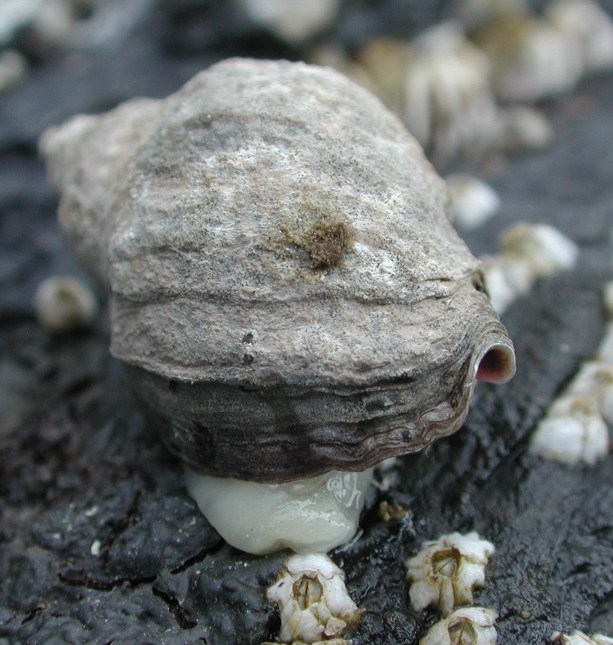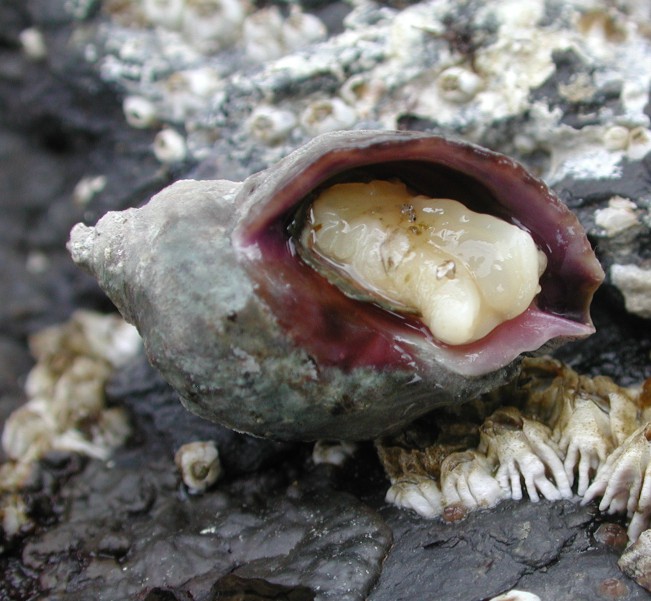Nucella ostrina (Deshayes, 1839)Common name: Emarginate dogwinkle, short-spired purple, northern striped dogwinkle, striped dogwinkle, ribbed dogwinkle, emarginate whelk, ribbed rock whelk, rock thais, short-spired purple snail, rock whelk |
|
| Synonyms: Nucella emarginata, Thais emarginata |  |
| Phylum
Mollusca
Class Gastropoda Order Neogastropoda Suborder Rachiglossa Family Nucellidae |
|
| Nucella ostrina collected on Northwest island, Rosario Bay, WA | |
| (Photo by: Nathaniel Charbonneau 7/26/02) | |
Linda Schroeder has added this helpful information for
distinguishing
this species from N.
lamellosa
based on the axial
lamellae:: "N.
ostrina
can definitely have axial
lamellae, but less common to see than on N.
lamellosa. The lamellae
are much closer together (photo)
than on N.
lamellosa (photo)
and also don’t protrude as much."
| This table lists some other general distinctions between N. lamellosa and N. ostrina:, based on information from the Oregon Institute of Marine Biology: | |
| Nucella lamellosa | Nucella ostrina |
| Habitat: Quiet water or wave action, intertidal or subtidal | Areas of wave action, intertidal |
| Shell length (height): To 5 cm or more | Usually < 2 cm, rarely > 3 |
| Shell thickness: Heavy, solid | Not heavy |
| Number of whorls: 5-7 | 3-4 |
| Outside
sculpture: Variable:
Rough waters: Flattened, angled whorls which are smooth or have 1-2 strong spiral ridges near top of each whorl |
No axial sculpture or small, close-spaced axial ruffles (photo). Spiral sculpture of multiple alternating large and small ridges which may be obscure (photo) or nodulose |
| Sutures: Not deep | Not deep |
| Aperture length: Nearly 1/2 shell length | More than 1/2 shell length |
| Aperture inside color: Whitish | Brown or purple (photo) (or yellow-photo) |
| Aperture outer lip: Thick, smooth with an inner row of several denticles deep within the aperture | Thinner, often crenulate outer lip with no denticles |
| Siphonal canal: Longer than 1/4 aperture length, not closed | Shorter than 1/4 aperture length, not closed |
How to Distinguish from Similar Species: Nucella lamellosa has longitudinal ridges or frilly lamellae as well as spiral ridges. Nucella canaliculata has spiral ridges of nearly equal size, and a deep groove separating whorls. N. ostrina was formerly called Nucella emarginata along our coast, but now the species has been recognized as two different species. N. emarginata looks similar but is found in southern California, while N. ostrina is found mostly in more northern locations such as here. N. emarginata can be distinguished from N. ostrina by the fact that it has a thickened "parietal nub" on the shell (the edge of the aperture above the columella is thickened), while that of N. ostrina is less so), it lays eggs which are more rounded and with shorter stalks, it is less elongated than N. ostrina, and the spiral ridges are more likely to have nodules on them.
Geographical Range: Ranges from Aleutian Islands (Alaska) to Cayucus (San Luis Obispo Co.)
Depth Range: High intertidal to low intertidal
Habitat: Rocky substrate where mussel beds are plentiful, mostly on the exposed outer coast.
Biology/Natural History: This species unlike limpets and periwinkles is a carnivore--one of the predatory whelks known as "oyster drills" or "barnacle drills". It hunts down intertidal barnacles, mussels, and sometimes periwinkles such as Littorina sitkana and L. planaxis or the limpet Collisella scabra, and uses its radula to drill through their protective shell. The primary food of adults is the mussel Mytilus trossulus, which it prefers over M. californianus, and the barnacle Balanus glandula. After drilling the whelk injects digestive enzymes into the prey's body cavity and sucks out the dissolved tissue using its long proboscis. This species is a formidable predator that aids in controling the population of barnacles and mussels. Individual snails seem to have narrow feeding preferences, while that of the population as a whole is broader. Predators of the species include the seaster Pisaster ochraceus and the red rock crab Cancer productus. The eggs, which the species attaches to rocks, may be eaten by the purple shore crab Hemigrapsus nudus or the isopod Idotea wosnesenskii, while the young may be eaten by hermit crabs such as Pagurus hirsutiusculus.
In his dissertation, Seavey (1977) reports that on the Oregon coast it takes approximately 14 months for eggs to mature in this species. Spermatogenesis occurs throughout the year. in males. Spawning begins in October and November in Oregon.
The yellow, vase-shaped egg capsules, which are attached via short stalks to rocks well up in the intertidal and called "sea oats", are about 6-8 mm high with a suture line along one side. Each capsule holds about 550 eggs, each of which is 180 to 220 microns in diameter. Most of the eggs are infertile "nurse eggs" which the other embryos devour as they develop. Development within the capsule takes about 2.5-4 months. Ten to 20 juvenile snails hatch from each capsule (there is no free planktonic stage). A single female may produce a cluster of up to 300 capsules.
In the study by Sorte and Hofmann (2005), thermotolerance of different Nucella species along the coast was found to be correlated with the latitude range and tidal height each species occupies. N. ostrina, which occurs higher in the intertidal than does N. canaliculata in Oregon and does not extend as far north, had higher heat tolerance than did N. canaliculata. N. emarginata, which extends the farthest south, and N. ostrina, which lives higher in the intertidal, recovered more quickly from thermal exposure than did N. canaliculata and N. lamellosa, which live lower in the intertidal, and N. lima, which has a more northern range. These differences in heat tolerance may be related to HSP70 molecular chaperones.
The famous purple dye from the city of Tyre, that colored royal Roman robes, was made from a relative of Nucella. The snails were ground up in a stone mortar; different combinations made different shades of purple. The dye should be fixed with lemon juice as a mordant. The American species produce a much less brilliant purple than do the Mediterranean species.
Shell banding is controlled by a single gene locus which
is separate
from shell color. In California the species contains high
levels
of metals, such as 570 ppm copper and 1700 ppm zinc.
| Return to: | |||
| Main Page | Alphabetic Index | Systematic Index | Glossary |
References:
Dichotomous Keys:
Carlton, 2007
Flora and Fairbanks, 1966 (as Thais emarginata)
Kozloff, 1987, 1996 (as N. emarginata)
General References:
Brusca
and Brusca, 1978
Griffith,
1967 (as Thais
emarginata)
Harbo,
1999
Johnson
and Snook, 1955 (as Thais emarginata)
Kozloff,
1993 (as N. emarginata)
Lamb
and Hanby, 2005
McConnaughey
and Mc'Connaughey, 1986
Morris,
1966 (as Thais
emarginata)
Morris
et al., 1980
Niesen,
1994
Niesen,
1997
O'Clair
and O'Clair, 1998 (as N. emarginata)
Ricketts
et al., 1985
White,
1976
Scientific
Articles:
Marko, Peter B., 1998. Historical allopatry and the
biogeography
of speciation in the prosobranch snail genus Nucella.
Evolution
52:3 757-774
Moran, Amy L., 1999. Size and performance of juvenile marine invertebrates: potential contrasts betweenintertidal and subtidal benthic habitats. American Zoologist 39:2 pp. 304-312
Rawlings, 1999. Adaptations to physical stresses in the intertidal zone: the egg capsules of neogastropod molluscs. American Zoologist 39:2 pp. 230-243 (As N. emarginata)
Seavy, Donald K., 1977. Seasonal gametogenesis and egg laying in the prosobranch gastropods Nucella lamellosa, Nucella emarginata, Searlesia dira, and Amphissa columbiana on the Oregon coast. Ph.D. dissertation, Oregon State University. 179 pp. (As N. emarginata)
Sorte,
Cascade J.B. and Gretchen E. Hofmann, 2005.
Thermotolerance and
heat-shock protein expression in northeastern Pacific Nucella
species
with different biogeographical ranges. Marine Biology 146:
985-993
General Notes and Observations: Locations, abundances, unusual behaviors, etc.:
Subject in the picture above was found on Northwest Island in Rosario Bay, in a mussel bed.
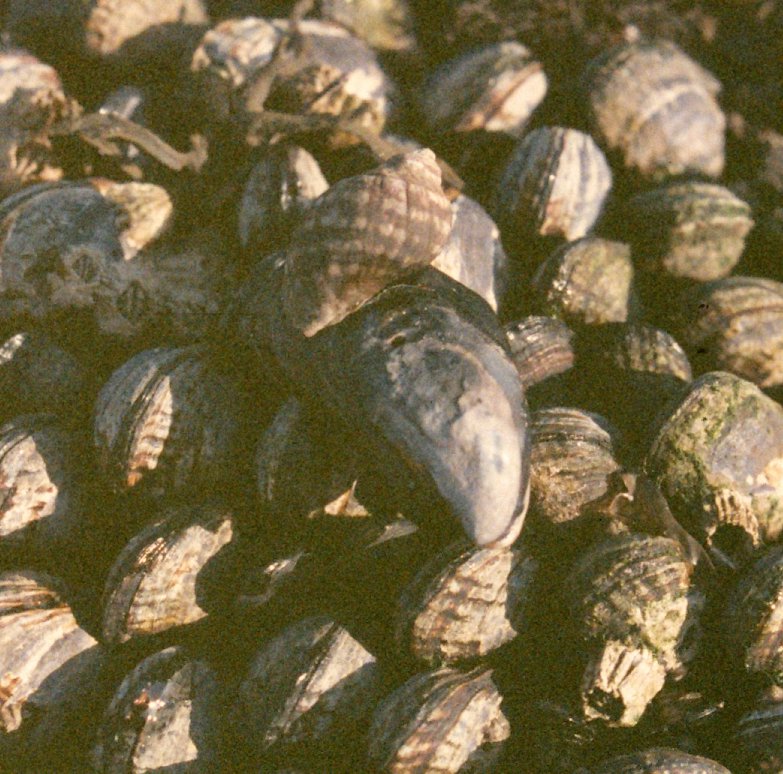
This individual was found by Dave Cowles at San Simeon, CA in 1995
in a Mytilus
californianus bed. It is drilling into a
mussel.
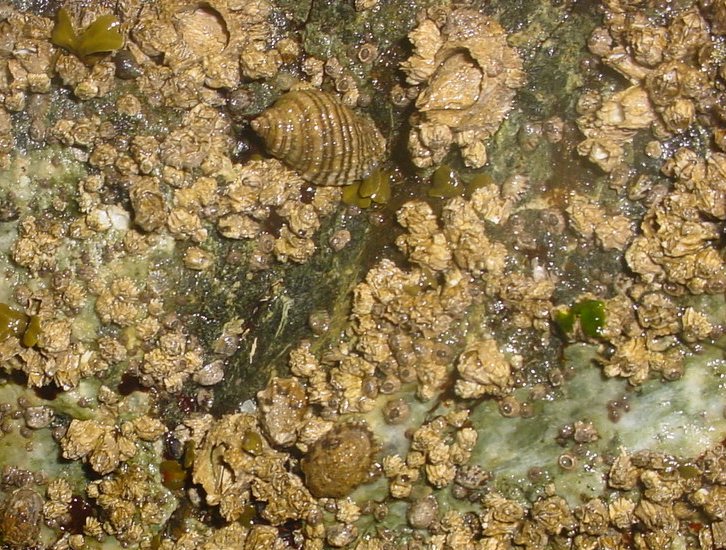
This individual is foraging among Balanus
glandula barnacles, a major prey species.
Night photo by
Dave Cowles, Sept 2005
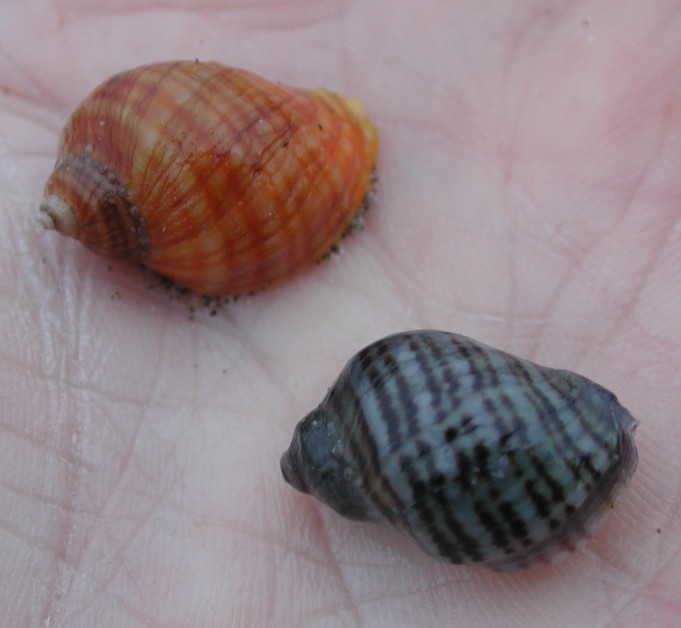
The species can be found in several colors, even on the same rock.
These were photographed at beach #4, Kalaloch, July 2008 by Dave Cowles
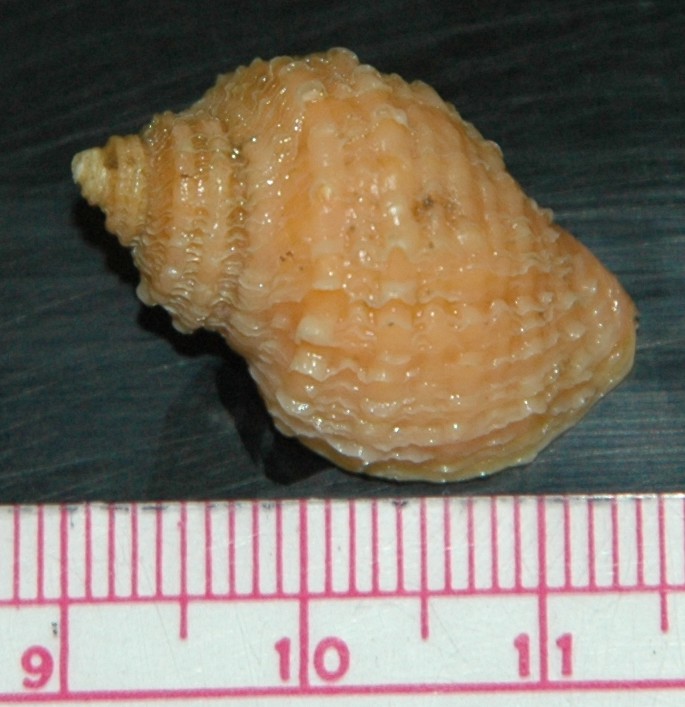
This orange inividual has small, but very obvious axial
lamellae and so could be mis-identified as N.
lamellosa. However, the alternating large and small spiral
ridges and the short spire
and siphonal
canal identify it as N. ostrina.
My thanks to Linda Schroeder for assistance in identifying this
specimen.
See the note and table with the description above for distinguishing
the
two species based on lamellae
and other features. Numbers on scale are centimeters. Photo by Dave
Cowles,
May 2005
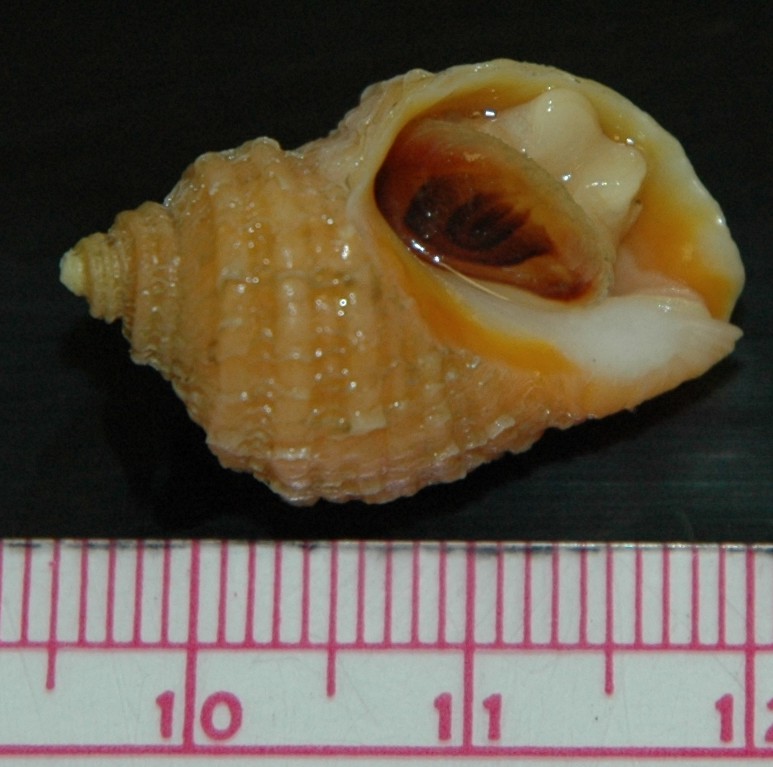
This same individual shows the horny operculum
with an off-centered spiral in it, the crenulated
outer lip of the aperture, white foot tissue, and a yellowish outer lip
which has no projecting tooth. Photo by Dave Cowles, May 2005

In the same individual, the creamy white foot is beginning to be
extended.
Scale marks are millimeters. Photo by Dave Cowles, May 2005
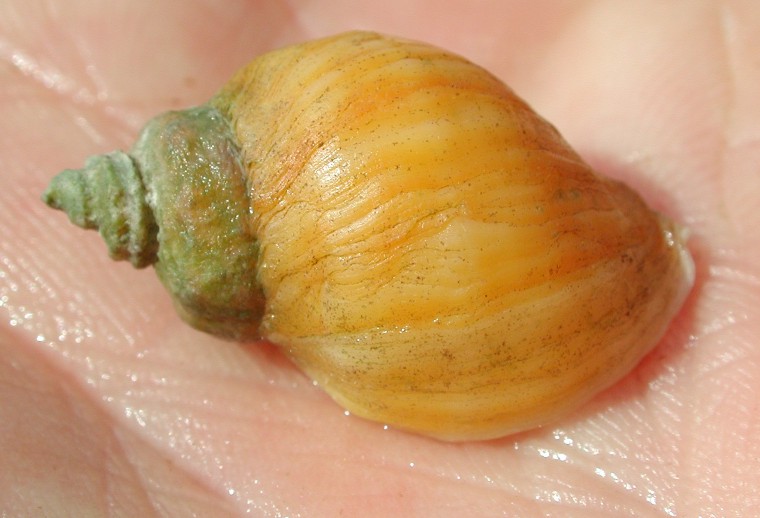
This orange individual is nearly smooth. My thanks to Linda Schroeder
for help identifying it as N. ostrina. Photo by
Dave Cowles, July
2007
Authors and Editors of Page:
Nathaniel Charbonneau created page 7-2002
Editors: Dave Cowles 8-2002, 2005, 2009
Hans Helmstetler 1-2003
